D2C Advertising Strategies to Scale Your Brand
As d2c marketing evolved, the online interaction of the consumers increased. Indian consumers have more online usage and interaction than the world. And the study mentions that about 50% of Indian consumers prefer virtual experiences to the real world (Source)
In India, the total addressable D2C market is expected to grow by over 15 times from 2015 to 2025.
Let us see in detail what D2C marketing is and how it can help you increase your business sales.
What is D2C Marketing?
D2C marketing, or Direct-to-Consumer marketing, is a business model in which companies sell their products or services directly to customers, bypassing traditional distribution channels like wholesalers, retailers, or middlemen.

- Instead of relying on intermediaries, D2C brands establish a direct relationship with consumers through e-commerce websites, mobile apps, social media, or even physical stores.
- D2C marketing allows companies complete control over the customer journey, from product development and production to marketing, sales, and customer support.
- By eliminating intermediaries, D2C brands can often offer lower prices to customers while maintaining higher profit margins.
- D2C marketing strategies often focus on building strong brand identities, cultivating customer relationships, and leveraging technology and data to personalise marketing messages and improve customer experiences.
Read: Beginner’s guide to performance marketing
Key Elements of D2C Marketing
Some key elements of D2C marketing include:
- E-commerce: D2C brands typically operate their own e-commerce websites or online platforms to directly sell products or services to customers. This allows greater control over the shopping experience and enables brands to gather valuable customer data.
- Social Media Marketing: D2C brands leverage social media platforms to raise brand awareness, engage with customers, and drive sales. They often create compelling content, run targeted ads, and utilise influencer marketing to reach their target audience.
- Customer Relationship Management (CRM): D2C brands strongly emphasise building and maintaining relationships with customers. They utilise CRM systems to collect and analyse customer data, enabling personalised marketing efforts, customer segmentation, and targeted promotions.
- Data-Driven Decision Making: D2C marketing relies heavily on data analysis to inform marketing strategies and improve customer experiences. Brands collect and analyse data from various sources, including customer behaviour, preferences, and feedback, to make informed decisions and drive growth.
- Brand Storytelling and Authenticity: D2C brands often emphasise their unique brand story and values to connect with customers on a deeper level. They aim to build authentic, transparent, relatable brands that resonate with consumers.
Benefits of D2C Digital Marketing
D2C digital marketing offers several benefits for companies that adopt this approach. Here are some key advantages:
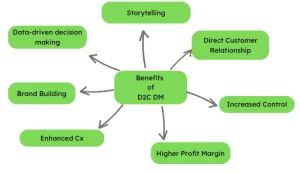
Direct Customer Relationship:
One of the primary benefits of D2C digital marketing is the ability to establish a direct relationship with customers. By selling products or services directly, companies can gather customer data, interact with them now, and gain valuable insights into their preferences, behaviours, and needs. This enables personalised marketing strategies, targeted promotions, and the ability to tailor the customer experience to individual preferences.
Increased Control and Flexibility:
D2C digital marketing gives companies full control over their brand image, messaging, and customer experience. They can directly manage every aspect of the marketing process, from product development and pricing to promotions and customer service. This control and flexibility enable companies to be agile, respond quickly to market trends, and adapt their strategies based on real-time feedback and data.
Higher Profit Margins:
D2C digital marketing can lead to higher profit margins by cutting out intermediaries. Without sharing profits with wholesalers, retailers, or distributors, companies can offer competitive prices to customers while maintaining healthy profit margins. This direct-to-consumer approach also allows for better cost control and optimising pricing strategies based on market demand and customer behaviour.
Enhanced Customer Experience:
D2C digital marketing enables companies to provide a seamless and personalised customer experience. By leveraging customer data, companies can tailor marketing messages, product recommendations, and offers to individual preferences. This level of personalisation fosters customer loyalty and satisfaction and increases the likelihood of repeat purchases. Moreover, direct communication channels allow for prompt customer support and efficient issue resolution, leading to higher customer satisfaction levels.
Brand Building and Storytelling:
D2C digital marketing allows companies to build a strong brand identity and engage with customers through compelling storytelling. By directly communicating with customers through various digital channels, companies can share their brand story, values, and mission, fostering a deeper connection and emotional attachment with consumers. This can lead to increased brand loyalty, advocacy, and word-of-mouth marketing.
Data-Driven Decision-Making:
D2C digital marketing relies on data analysis to drive decision-making. Companies can collect and analyse customer data, website analytics, and campaign performance metrics to gain insights into consumer behaviour, preferences, and market trends. This data-driven approach allows for more informed marketing strategies, better targeting, and the real-time optimisation of campaigns.
How to make a D2C marketing strategy for your brand?
Developing a direct-to-consumer (D2C) marketing strategy involves several vital steps to ensure success. Here’s a general framework to help you create an effective D2C marketing strategy:
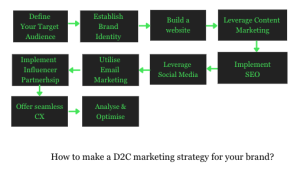
Define Your Target Audience:
Clearly identify and understand your target audience. Consider demographics, psychographics, and purchasing behaviours. This information will guide your marketing efforts.
Establish Brand Identity:
Develop a strong and consistent brand identity that resonates with your target audience. This includes creating a unique brand voice, visual elements, and values that differentiate your brand from competitors.
Build an Engaging Website or E-commerce Platform:
Create a user-friendly website or e-commerce platform that effectively showcases your products or services. Optimise it for easy navigation, responsive design, fast loading times, and secure payment gateways.
Leverage Content Marketing:
Produce high-quality and relevant content that educates, entertains, or adds value to your audience. Utilise various content formats like blog posts, videos, infographics, and social media posts to engage with your target audience and establish thought leadership.
Implement Search Engine Optimization (SEO):
Optimise your website and content for search engines to improve visibility and organic traffic. Research relevant keywords, create compelling meta tags, and build quality backlinks to improve your search engine rankings.
Leverage Social Media:
Identify the social media platforms that align with your target audience and develop a strong presence on those platforms. Share engaging content, interact with your audience, run targeted ads, and leverage social commerce features to drive traffic and conversions.
Utilise Email Marketing:
Build an email list by offering incentives like exclusive discounts, content upgrades, or newsletters. Use email marketing to nurture leads, provide personalised recommendations, and drive repeat purchases.
Implement Influencer Partnerships:
Collaborate with influencers or industry experts who align with your brand values and have a substantial following. Influencer marketing can help expand your reach, build credibility, and generate sales.
Offer Seamless Customer Experience:
Focus on delivering exceptional customer service and a seamless buying experience. Optimise your website’s checkout process, provide multiple payment options, offer hassle-free returns, and address customer queries promptly.
Analyse and Optimise:
Continuously monitor and analyse key performance indicators (KPIs) to measure the effectiveness of your D2C marketing efforts. Use tools like Google Analytics to track website traffic, conversion rates, customer acquisition costs, and lifetime value. Based on the insights, refine your strategy, and experiment with new tactics to improve results.
D2C Advertising Strategies to Scale your Brand
When scaling your brand through D2C (Direct-to-Consumer) advertising, several effective strategies exist. Here are some key tactics:
Social media advertising
Leverage the power of social media platforms such as Facebook, Instagram, Twitter, and LinkedIn to reach and engage your target audience. Use advanced targeting options to narrow your audience based on demographics, interests, and behaviours. Create compelling ad creatives and test different variations to optimise performance.
Bewakoof’s social media advertising strategy involves engaging its target audience, primarily youth. They create visually captivating content, including images and videos, to grab attention and drive engagement.

The brand leverages influencer collaborations to expand their reach and tap into the influencer’s loyal followers.
They also incorporate user-generated content to showcase real-life experiences and encourage community participation. Bewakoof actively responds to customer inquiries and feedback to foster a sense of brand loyalty and trust.
Bewakoof social media advertising strategy focuses on building a vibrant and interactive online community while staying true to its brand identity.
Influencer marketing
Collaborate with influential individuals in your industry with a significant following and credibility. Partner with relevant influencers to promote your products or services to their audience. This can increase brand awareness, generate trust, and drive sales. Ensure the influencers align with your brand values and target audience for maximum impact.
The Souled Store employs an effective influencer strategy to enhance its brand presence. The brand has leveraged the reach of OTT stars like Barkha Singh, Mithila Palkar, etc.

They identify relevant influencers who resonate with their target audience, typically fans of pop culture and fandoms. The influencers create engaging content featuring The Souled Store’s products, often including discount codes or special offers to incentivize their followers.
This strategy helps expand the brand’s visibility, drive traffic to its website, and generate sales. The Souled Store maintains long-term partnerships with influencers to maintain a consistent presence and capitalise on the influencers’ loyal fan base.
Content marketing
Develop high-quality content that educates, entertains, or provides value to your target audience. Create blog posts, articles, videos, infographics, or podcasts that align with your brand and industry.
Distribute this content through channels such as your website, social media, email newsletters, and guest blogging on industry websites to build brand authority and attract potential customers.
The Man Company implements a robust content marketing strategy to establish authority and engage its target audience. They create informative and engaging content around men’s grooming, including blog posts, articles, and videos.
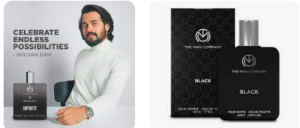
This content provides valuable tips, product recommendations, and grooming routines to educate and empower their customers. They also collaborate with influencers and experts to create compelling content that resonates with their audience.
he Man Company’s content marketing strategy helps build trust, drive organic traffic to its website, and position itself as a go-to resource for men’s grooming needs.
Search engine marketing (SEM):
Utilise paid search advertising platforms like Google Ads to target specific keywords related to your products or services. Create compelling ad copy and landing pages that align with user intent. Monitor and optimise your campaigns based on performance data to maximise your ROI (ROI).
Myntra implements an effective search engine marketing (SEM) strategy to increase its online visibility and drive targeted traffic to its platform. They conduct extensive keyword research to identify relevant search terms their target audience uses.
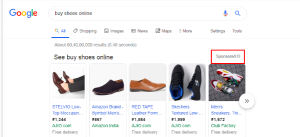
Myntra then optimizes its website content and creates targeted ads to appear prominently in search engine results. They also use retargeting campaigns to engage with users interested in their products. Myntra’s SEM strategy helps them capture qualified leads, enhance brand visibility, and drive conversions on their e-commerce platform.
Retargeting campaigns
Implement retargeting campaigns to reach users who have previously visited your website or engaged with your brand. This lets you stay top-of-mind and remind potential customers about your products or services. Use dynamic ads that showcase specific products or personalised recommendations based on users’ browsing behaviour.
Tata Cliq employs a robust D2C remarketing strategy to re-engage with its website visitors and drive conversions. They utilise cookies and pixel tracking to track user behaviour and create personalised re-marketing campaigns.
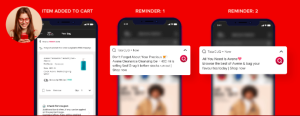
Through targeted ads and email marketing, Tata Cliq reminds users about products they have shown interest in, offers personalized recommendations, and provides exclusive discounts and promotions to incentivize purchases.
This re-marketing strategy helps TataCliq maintain brand visibility, increase customer engagement, and boost sales on its direct-to-consumer platform.
Email marketing
Build an email list of interested prospects and customers and use email marketing campaigns to nurture and convert them. Segment your email list based on preferences and purchase history to send targeted and personalised messages. Include exclusive offers, product recommendations, and valuable content to engage subscribers and drive sales.
Bluestone effectively utilizes D2C by sending personalized and targeted emails to their subscribers, featuring product recommendations, exclusive offers, and updates on new collections.

By leveraging email marketing automation and segmentation, Bluestone ensures relevant content reaches the right audience, fostering engagement and maximising the effectiveness of their direct-to-consumer efforts.
Affiliate marketing
Partner with affiliates who can promote your products or services to their audience in exchange for a commission on each sale. This can help you reach new customers through the affiliates’ networks and benefit from their marketing efforts. Set up a tracking system to accurately attribute sales and measure the performance of your affiliate program.
Mamaearth collaborates with influencers, bloggers, and content creators who align with their brand values and target audience. Through unique affiliate links or discount codes, these affiliates promote Mamaearth’s products on their platforms, earning a commission on every referred sale.
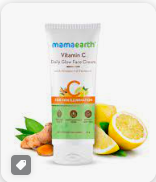
This affiliate marketing strategy enables Mamaearth to tap into the influencers’ loyal followers, increase brand visibility, and achieve higher conversions on their direct-to-consumer platform.
User-generated content (UGC)
Encourage your customers to create and share content featuring your products or services. This can be through reviews, testimonials, social media posts, or videos.
UGC adds social proof and authenticity and can help build trust with potential customers. Offer incentives or run contests to incentivize users to generate more UGC.
By showcasing authentic UGC, WakeFit creates a sense of community, fosters social proof, and leverages the power of word-of-mouth marketing to drive sales on its direct-to-consumer platform.

WakeFit effectively utilizes D2C user-generated content (UGC) to enhance brand engagement and build customer trust. They encourage their customers to share their experiences and reviews through social media posts, testimonials, and website reviews.
Native advertising
Use native advertising platforms to promote your brand in a non-disruptive way that blends with the platform’s user experience. Native ads are designed to match the look and feel of the platform, increasing the likelihood of engagement.
Examples include sponsored articles, recommended content, or promoted listings on relevant websites or mobile apps.
Chumbak employs D2C native advertising to seamlessly integrate its brand into relevant online content. They create sponsored articles, videos, and social media posts that align with the interests of their target audience.

By blending its brand messaging with valuable content, Chumbak effectively reaches and engages potential customers, driving traffic and conversions on its direct-to-consumer platform.
Data-driven optimisation
Continuously monitor and analyse the performance of your advertising campaigns. Use analytics tools to track key metrics such as click-through rates, conversion rates, and customer acquisition costs.
Optimise your campaigns based on the insights gained, allocate your budget to the most effective channels, and refine your targeting to drive better results.
Netflix leverages data-driven marketing strategies in its direct-to-consumer (D2C) approach. They personalise content recommendations and targeted advertising campaigns by analysing user preferences, viewing habits, and engagement patterns.

This data-driven approach allows Netflix to deliver personalised experiences, optimise user acquisition and retention efforts, and ultimately enhance customer satisfaction on its streaming platform.
Examples of D2C Digital Marketing
Mamaearth is an Indian personal care brand that has effectively implemented a direct-to-consumer (D2C) marketing strategy. Here are some critical elements of their approach:
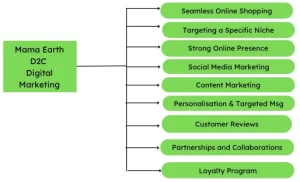
Targeting a Specific Niche:
Mamaearth provides toxin-free and natural products for babies, moms, and men. By catering to a specific niche, they have positioned themselves as a trusted brand for safe and gentle personal care products.
Strong Online Presence:
Mamaearth has built a strong online presence through its website and social media channels. Their website is a central hub for product information, customer reviews, and online purchasing.
Social Media Marketing:
Mamaearth leverages various social media platforms, including Facebook, Instagram, and YouTube, to connect with its target audience. They create engaging and informative content about parenting, skincare, and health. They also collaborate with influencers and encourage user-generated content, which helps to amplify their reach and build brand advocacy.
Content Marketing:
Content marketing plays a significant role in Mamaearth’s D2C strategy. They produce valuable and educational content through blog posts, videos, and social media posts. This content focuses on parenting tips, ingredient knowledge, and skincare routines. They position themselves as an authoritative brand in the personal care space by providing valuable information.
Personalization and Targeted Messaging:
Mamaearth focuses on personalization by tailoring its messaging and offers to specific customer segments. They send targeted emails and notifications based on customer preferences, previous purchases, and lifecycle stages. This personalised approach helps in nurturing customer relationships and driving repeat purchases.
Customer Reviews and Testimonials:
Mamaearth encourages customer reviews and testimonials on its website and social media platforms. Positive reviews and testimonials act as social proof and build trust among potential customers. They actively engage with their customers, addressing queries and concerns promptly, further enhancing their brand reputation.
Partnerships and Collaborations:
Mamaearth collaborates with influencers, parenting bloggers, and health experts to promote their products. They leverage these partnerships to reach a wider audience and tap into their partner’s loyal followers.
Seamless Online Shopping Experience:
Mamaearth’s website is designed for a seamless online shopping experience. It provides detailed product descriptions, easy navigation, secure payment options, and customer reviews. They also offer free shipping and hassle-free returns, which enhances customer satisfaction.
Loyalty Program:
Mamaearth has implemented a loyalty program called “Mama Rewards,” where customers earn points on their purchases that can be redeemed for discounts on future orders. This program incentivizes repeat purchases and encourages customer loyalty.
Constant Innovation:
Mamaearth continually introduces new products and expands its product range based on customer feedback and market trends. This commitment to innovation keeps their customers engaged and interested in their brand.
Conclusion
D2C marketing offers brands a direct pathway to engage with consumers and drive growth. With a focus on targeted messaging, personalised experiences, and digital channels, brands like Mamaearth have showcased the effectiveness of this strategy.
To harness the potential of D2C marketing, partner with Noboru World. Contact us at hello[at]noboruworld.com and let our experts guide you towards a successful D2C marketing strategy. Unlock new opportunities today!
FAQ
What is D2C marketing?
D2C marketing is the practice of selling products or services directly to consumers without the involvement of intermediaries.
Why is D2C marketing popular?
D2C marketing allows brands to have more control over the customer experience, collect valuable data, and increase profitability.
What are the benefits of D2C marketing?
Benefits include stronger customer relationships, better data insights, increased profitability, agility, and brand control.
What are the critical components of a D2C marketing strategy?
Key components include an e-commerce platform, customer data management, digital marketing channels, fulfilment and logistics, and customer support.
How can brands drive traffic to their D2C channels?
Brands can use content marketing, social media marketing, influencer marketing, SEO and SEM, and email marketing to drive traffic to their D2C channels.
How can brands provide a personalised experience in a D2C model?
Brands can leverage customer data, implement personalization tools, and tailor marketing messages to provide a personalised experience in a D2C model.



